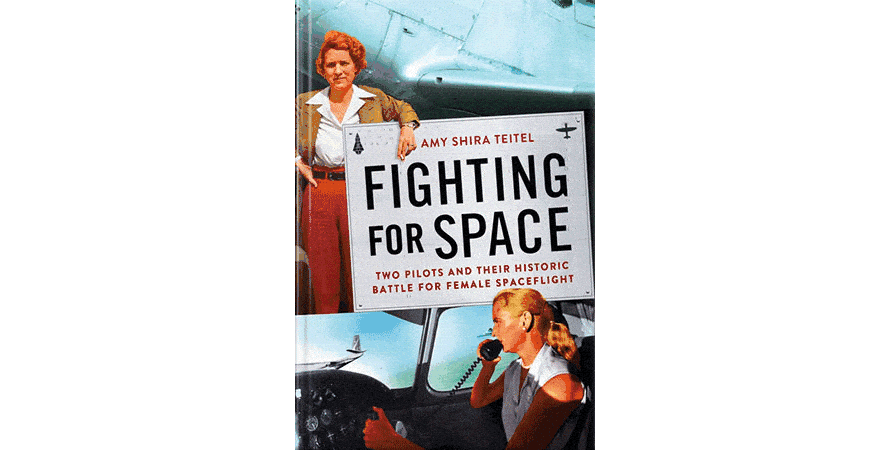Category: Non-Fiction
Reviewed by: Loretta Hall
Title: Fighting for Space: Two Pilots and Their Historic Battle for Female Spaceflight
Author: Amy Shira Teitel
NSS Amazon link for this book
Format: Hardcover/Kindle
Pages: 448
Publisher: Grand Central Publishing
Date: February 2020
Retail Price: $30.00/$13.99
ISBN: 978-1538716045
Author Amy Shira Teitel skillfully uses the dual biography format in this revealing examination of the personalities and careers of Jackie Cochran and Jerrie Cobb. Both women aggressively pursued their aviation careers, setting multiple speed, altitude, and distance records. Both were determined individuals who doggedly persisted in what they wanted to accomplish. They met head-to-head in the early 1960s when Dr. Randy Lovelace began testing women’s potential suitability as astronauts.
Teitel highlights the relative ages and experience levels of the two women by dovetailing their stories along a common timeline. We first meet Cobb as a young child in Chapter 4, following a description of Cochran’s career accomplishments, which are so significant that a story about her appeared in “the September 12, 1938, issue of Newsweek that featured Adolf Hitler on the cover.” A few chapters later, we see Cobb take her first airplane ride at age twelve in 1943 at about the same time Cochran was named “head of all women flying for the AAF [Army Air Force].” In typical fashion, Cochran muscled her way into that position to gain advantage over another female aviator who had established a competing program. Cochran had organized the WASPs, a program for women pilots to fulfill noncombat flying missions to free up male pilots for military action.
Ultimately, Cobb and Cochran both felt entitled to be recognized as the leader of a group of women who later became known as the Mercury 13. Cobb had been the first woman pilot to pass the same exhaustive physical examinations that America’s first astronauts (all men) had passed. Cochran, with the help of her wealthy husband, had helped finance the Lovelace testing program, in which another dozen women also passed the exams.
Historical context adds to this story. For example, Jim Webb’s appointment as head of NASA in February 1961 is followed by news that Wally Funk had become the third woman to pass the Lovelace exams. A few days later, Marion Dietrich began the tests. By late March, we see John Glenn beginning his frustrations with not being selected for America’s first (suborbital) manned spaceflights. We also learn of Cochran’s personal friendships with military brass and politicians (including Lyndon Johnson) whom she could call upon to advance her objectives.
Teitel’s diligent research in several historical archives adds to the story’s credibility. In fact, it would have been useful to include an index to make that information more accessible. The author explains at the end of the book that she chose not to clutter the book with “1,216 footnotes” but simply included a list of sources for each chapter.
On the other hand, two statements left me wishing for more specific documentation. As a space historian myself, I am pretty familiar with the Lovelace testing program; in fact, I recently helped Wally Funk write her memoir. One statement that surprised me was in a letter that Cochran’s husband, Floyd Odlum, wrote to his friend General Jimmy Doolittle. Odlum took it upon himself to write on behalf of his wife, as she was unavailable. He said Cochran had told him that Cobb had invited herself to take the Lovelace tests and failed on her first attempt. He continued, “she was so determined she returned months later, at Randy’s invitation and after undergoing a fitness regimen, to retake the tests. This time she passed.” However, Dr. Lovelace’s own accounts tell how he met Cobb and invited her to take the tests, and I have never seen another reference to her failing on a first attempt. Without specific documentation, I’m left to wonder if this was just the remnants of a spiteful outburst Cochran may have made to her husband. In contrast, I have seen credible statements that Cochran herself took the tests and responded angrily when Lovelace told her she did not pass—something not mentioned in this book.
The other surprising statement I found was about Cobb’s experience in the isolation test, which she arranged for on her own after the Lovelace testing. In her “Author’s Note,” Teitel writes, “Jerrie’s first memoir is also my source for saying she spent nine hours in Dr. Shurley’s isolation tank on page 216, but there’s speculation she didn’t actually last that long.” I had not heard such speculation. Who suggested it and how credible were they? To be so specific as to reference the page in Cobb’s memoir but so vague in referring to contrasting speculation is puzzling.
Overall, though, this is an engaging book to read, with a broader historical context than just the personalities of Cochran and Cobb. It is well worth reading.
© 2020 Loretta Hall
Please use the NSS Amazon Link for all your book and other purchases. It helps NSS and does not cost you a cent! Bookmark this link for ALL your Amazon shopping!



















